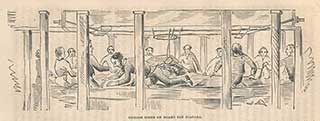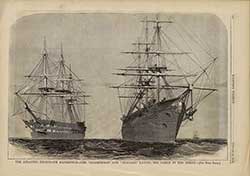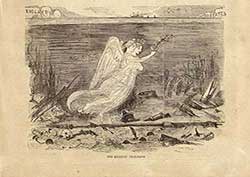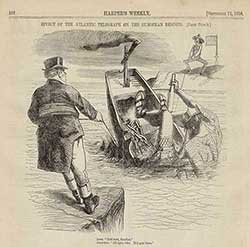
Displaced Representation and Nationalistic
Appropriation: Illustrating the Atlantic
Cable of 1858
- Mark Niemeyer
_______________________________


Fig. 23. The Agamemnon and the Niagara in
Mid-Ocean, 1858 

Fig. 26. Telegraph Station on the American
Terminus, 1858 

Fig. 27. Allegory of the Atlantic Cable, 1858 

Fig. 28. Effect of the Atlantic Cable on European
Despots, 1858 
In any case, the often relatively basic, sometimes literalistic, sometimes exceedingly technical, not to say (anachronistically and somewhat informally) geeky, approaches to illustrating the cable reviewed thus far were employed by the popular press in newspapers and magazines as well. The widely distributed New York-based Harper’s Weekly, for example, reproduced technical drawings of an overhead view of the paying-out machine and a side view of the brake machinery and drums for paying out the cable (figs 16 & 17  ) as well as representations of the ocean floor, showing the relatively flat surface of the so-called “telegraph plateau” running east-west and the much more rugged and uneven surface of the ocean floor on its north-south axis (figs 18 & 19
) as well as representations of the ocean floor, showing the relatively flat surface of the so-called “telegraph plateau” running east-west and the much more rugged and uneven surface of the ocean floor on its north-south axis (figs 18 & 19  ). The newspapers and magazines and Mullaly, however, also tried to humanize even the more technical aspects the Atlantic Cable by including people in their illustrations alongside, or even interacting with, the machinery or the cable itself. One illustration from another major New York weekly, Frank Leslie’s Illustrated Newspaper, for example, shows men on board the Niagara supervising the paying out of the cable from one of the large coils carried within the hold, and another, from a later issue of the same newspaper, shows the operators’ room, from which telegraphers maintained contact between the two ships during the voyage, and includes other men also supervising the cable as it is pulled from one of the coils (figs 20 & 21
). The newspapers and magazines and Mullaly, however, also tried to humanize even the more technical aspects the Atlantic Cable by including people in their illustrations alongside, or even interacting with, the machinery or the cable itself. One illustration from another major New York weekly, Frank Leslie’s Illustrated Newspaper, for example, shows men on board the Niagara supervising the paying out of the cable from one of the large coils carried within the hold, and another, from a later issue of the same newspaper, shows the operators’ room, from which telegraphers maintained contact between the two ships during the voyage, and includes other men also supervising the cable as it is pulled from one of the coils (figs 20 & 21  ). The illustration of a similar scene in Mullaly’s book is somewhat less professionally drawn and is almost cartoonish in its depiction of men in the process of coiling a length of cable in preparation for paying it out (fig. 22). In any case, the image certainly succeeds in giving a human face to the project in a way that the illustrations of the cable itself or the various apparatuses and machinery related to the history and the laying of the cable alone do not.
). The illustration of a similar scene in Mullaly’s book is somewhat less professionally drawn and is almost cartoonish in its depiction of men in the process of coiling a length of cable in preparation for paying it out (fig. 22). In any case, the image certainly succeeds in giving a human face to the project in a way that the illustrations of the cable itself or the various apparatuses and machinery related to the history and the laying of the cable alone do not.
In a further remove from illustrating the cable itself or the more technical aspects of the enterprise, the popular press frequently portrayed the two ships that laid the cable, the American Niagara and the British Agamemnon, and the site of the two endpoints of the cable, Trinity Bay, Newfoundland, and Valentia Bay, Ireland, in ways that emphasize the grandeur of the enterprise, and which frequently don’t include the cable itself at all. A full-page illustration dominated by the two ships that appeared in Harper’s Weekly—indeed, in the case of the Niagara its mast extending beyond the upper frame of the image—gives an idea of an attempt to confer an aura of magnificence on the project (fig. 23). The illustrations focusing on the endpoints the cable, however, employ a somewhat different, even opposite, strategy, and—while still celebrating the human exploit, and notably the role of the various ships in the “telegraph squadron” (other ships accompanied the Niagara and the Agamemnon, though they were not directly involved in the laying of the cable)—often highlight the sublimity and grandeur of Nature in comparison to the ships and men on shore there to greet them (figs 24 & 25  ). These illustrations thus seem to magnify the achievement by showing the immensity of Nature that the successful completion of the Atlantic Cable had, to a certain extent, tamed or overcome while, at the same time, implying that this new technology had a natural place amidst Nature. This latter point of view is especially strongly suggested in an illustration of the telegraph station on the American terminus of the cable that appeared in Frank Leslie’s Illustrated Newspaper (fig. 26). Here, the clapboard telegraph station, with a small plume of smoke gently rising out of its chimney, resembles a well-kept farmhouse nestled in a bucolic setting, complete with trees, fields, a quiet stream and even cows, one of which is being milked. The men who apparently have something to do with the telegraph itself are all in the background, dwarfed, to a large extent, by the expanse of Nature, and, furthermore, do not seem to be in any way disturbing the pastoral bliss. This presentation, in fact, offers a reversal of the archetypical image of the intrusion of “the machine in the garden” identified by Leo Marx, in which an account (here a visual illustration) of “the pleasures of withdrawal from the world—a simple pleasure fantasy—is transformed by the interruption of the machine into a far more complex state of mind.” [6] Granted, a telegraph wire and station provide a much less dramatic and less violent interruption of the pastoral scene than the archetypical examples of technology in mid-nineteenth-century America, the steam locomotive or Mississippi riverboat. The intrusion, however, is nonetheless present, and the illustration clearly offers the message that the Atlantic Cable will not disrupt the natural scene or, for that matter, the natural balance of life.
). These illustrations thus seem to magnify the achievement by showing the immensity of Nature that the successful completion of the Atlantic Cable had, to a certain extent, tamed or overcome while, at the same time, implying that this new technology had a natural place amidst Nature. This latter point of view is especially strongly suggested in an illustration of the telegraph station on the American terminus of the cable that appeared in Frank Leslie’s Illustrated Newspaper (fig. 26). Here, the clapboard telegraph station, with a small plume of smoke gently rising out of its chimney, resembles a well-kept farmhouse nestled in a bucolic setting, complete with trees, fields, a quiet stream and even cows, one of which is being milked. The men who apparently have something to do with the telegraph itself are all in the background, dwarfed, to a large extent, by the expanse of Nature, and, furthermore, do not seem to be in any way disturbing the pastoral bliss. This presentation, in fact, offers a reversal of the archetypical image of the intrusion of “the machine in the garden” identified by Leo Marx, in which an account (here a visual illustration) of “the pleasures of withdrawal from the world—a simple pleasure fantasy—is transformed by the interruption of the machine into a far more complex state of mind.” [6] Granted, a telegraph wire and station provide a much less dramatic and less violent interruption of the pastoral scene than the archetypical examples of technology in mid-nineteenth-century America, the steam locomotive or Mississippi riverboat. The intrusion, however, is nonetheless present, and the illustration clearly offers the message that the Atlantic Cable will not disrupt the natural scene or, for that matter, the natural balance of life.
Other strategies of illustrating the Atlantic Cable were much more symbolic and stressed, for example, the positive effect that the improved communication provided by the new link would supposedly have. Indeed, many people at the time thought that the ocean telegraph would help promote peace in the world, an idea expressed, for example, in a poem entitled “The Mission of the Cable,” which appeared in the New York Evening Post. In that poem, the cable is addressed directly and asked whether or not it would seek to instill peaceful thoughts in the nations of the world. It responds affirmatively, “Aye, amicable! that I will!” [7] The idea of peace is dramatically portrayed in an allegorical image that appeared on the cover of Harper’s Weekly on August 14, 1858 (fig. 27). Here, two angels or goddesses, apparently representing America and Great Britain, one of which is holding an olive branch, float through the water along the length of the cable. Strewn about on the ocean floor are various objects symbolic of violence and war, including skulls with bullet holes in them, a pistol, cannon barrels and a sword, among other debris, all now consigned to the deep.
In a similar vein, a political cartoon entitled “Effect of the Atlantic Cable on European Despots” suggests that the Atlantic Cable will promote democracy in the world by helping to bring down these “European despots” (fig. 28). How exactly this would take place is not made explicit, but that it would somehow result from increased cooperation between the United States and Great Britain is clearly suggested. Indeed, the idea that the cable would solidify and improve relations between the two English-speaking democracies was held by many, as the cooperation displayed in this political cartoon between the common nineteenth-century caricatures representing them (John [Bull] and [Brother] Jonathan) highlights. A similar theme also featuring caricatures representing the two countries (though in this case Brother Jonathan resembles Uncle Sam) is presented on a souvenir coin issued to commemorate the completion of the Atlantic Cable (figs 29 & 30  ). On the obverse, the two figures greet each other across the Atlantic Ocean with lightning bolts leaping out of their hands, while a ship, in the process of laying the cable, steams its way from shore to shore. John Bull exclaims: “How are you Jonathan”? The figure representing the United States, in a somewhat standardized dialectical American English, replies, “Purty well old feller / Heow’s yerself”? The message is vaguer than the one in the political cartoon, but the idea of friendly, or friendlier, relations between the two countries is clearly present. While I will develop this point further, later on, it should be noted here already that the expressions of Anglo-American brotherhood in relation to the Atlantic Cable were at least somewhat forced, if not outright ironic, since the two countries had, at the time, about as many reasons to be suspicious of each other as to be trustful of one another.
). On the obverse, the two figures greet each other across the Atlantic Ocean with lightning bolts leaping out of their hands, while a ship, in the process of laying the cable, steams its way from shore to shore. John Bull exclaims: “How are you Jonathan”? The figure representing the United States, in a somewhat standardized dialectical American English, replies, “Purty well old feller / Heow’s yerself”? The message is vaguer than the one in the political cartoon, but the idea of friendly, or friendlier, relations between the two countries is clearly present. While I will develop this point further, later on, it should be noted here already that the expressions of Anglo-American brotherhood in relation to the Atlantic Cable were at least somewhat forced, if not outright ironic, since the two countries had, at the time, about as many reasons to be suspicious of each other as to be trustful of one another.


